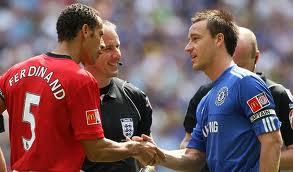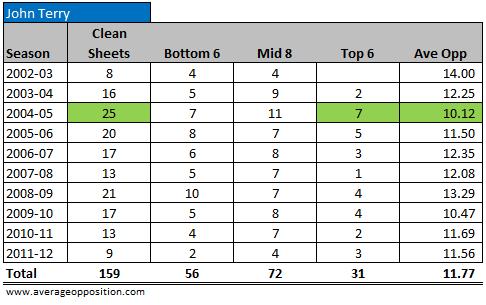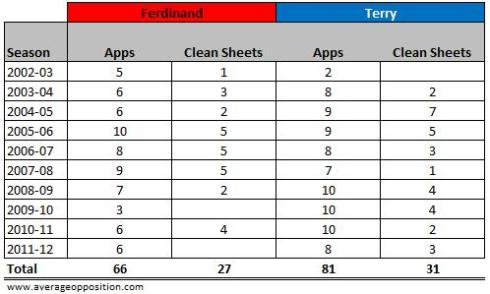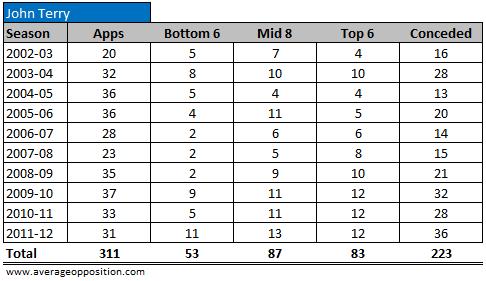Arsenal improved from last season? Nope. Man Utd destined to finish outside the Top 4? Unlikely. In what is the first ever guest post, Michael Geaghan makes his Premier League predictions based on the season so far and the results in the remaining corresponding fixtures from last season.....
How to
interpret this?
Buy:
Sell:
How it works, The Assumptions.
We assume the previous season’s results as the starting point for the current season.
Man City to
win the league. Arsenal guaranteed top 4. Man Utd’s league season already
finished. Palace to get relegated. Newcastle top half. Maybe, Maybe not.
They say a
league only tells the truth at the end of the season. We saw a glimpse of the reality
behind this at the midway point in the current season, where the only change in
the top 4 was Everton replacing Man Utd in the coveted Champions League
positions, even though the talk for the first 15/16 games of the season was
whether Liverpool could mount a challenge on the league title only to finish the
halfway point in 5th and 6 points behind the leaders.
Every fan
has their own memories of their own personal experience of luck at the timing
of playing teams, injuries, after a midweek game, whilst the opposition are on
a good run, a bad run, the same applying for their team. Starting games with
confidence has a huge effect on the outcome of results, but the simplicity is
that all teams play each team home and away. At the start of each season each
manager will identify where they are going to pick up points, and at the same
time expectations are managed post games as to whether their teams have
‘dropped points’ or gained bonus unexpected points.
Every week
I overwrite the previous season’s results with the current season’s – for the
corresponding fixtures. For example, Arsenal are generally touted as the ‘most
improved team of the season so far’. That isn’t actually the case. Although
they were top of the league at the halfway point and remain there as I write,
they are in fact one point worse off than the same games last season. We all
remember, I certainly do as a spurs fan, the incredible run that Arsenal went
on towards the end of the season that has slightly skewed the figures, but it
does show that they have now consistently been a good team for quite some time.
The season finishing and restarting just fell at the wrong time as the last 12 months have definitely showed champion consistency and quality, just not in the same season...so far anyway. This
also points towards the basis for this, in looking at the premier league table
now and as a forecast for the final positions. If the results are as similar as
last season, as has been the case so far, they could even find themselves
outside of the top four.
After 21
games, as mentioned above, Arsenal are one point worse off than the same games
played last season. I mentioned I am a spurs fan, they are actually one point
better off. Clearly though, Arsenal are entering the final 17 games of the
season with confidence and with a very different pressure hanging over their
shoulders. The games they struggled in last season are the games they have yet to
play.
I think a
fair argument is that Man City are the best footballing team in the league at
the moment and they have the strongest squad, they are though competing on four
fronts. they are brutal in front of goal regardless of who the opposition is. The recent game at Newcastle goes to show though that they can get beat, they
didn’t, a crazy refereeing decisions helped make sure they got all three points on the day, but
they are not indestructible. Their start of season questionable away form appears to have been eradicated. They have already accumulated a staggering 16 points more than in the same games last season. Plus they have achieved this with a little more
panache than last season, 28 goals more than the correlating games last season (see goals comparison in the table below).
With the bookies end of season points tally spread for City currently set at 82.5-84 I would
certainly be buying that, as they are on target for around 88 points.
Inheriting last seasons results to complete the league forecast will result in
them winning every home game. At home they only have Chelsea, of the so called
‘big teams’, to entertain at the Etihad and so that is not an unachievable
target. Away from Manchester they inherit results from last season where they
picked up only 14 points (from a possible 24) from the remaining 8 games they
have left on the road.
At the
bottom of the league, the promoted teams within this system inherit the
respective relegated team from last season - Cardiff assume Wigan’s results,
Hull assume Reading’s and Palace assume QPR’s. This only really stands due to
the team staying in the premier league retaining their results and so implying
the result against the promoted teams. The games played against each other is
the obvious draw back in this system.
Of the
promoted teams though interestingly, and at the same time worryingly for
Cardiff and Palace, is that on a like for like comparison Cardiff have
accumulated exactly the same amount of points as Wigan had over the same games
last season and Palace are 1 point worse off - and that’s against a miserable
return of only 25 points that QPR managed to get last season. It’s been quite
obvious to see that Hull have certainly done themselves proud in the first half
of the season and are well on their way to achieving the 40 points target. On
that note I think it may be as low as a good goal difference on 36 points
needed to stay in the division this season.
Man Utd at
the top end of the division finished the league 11 points better off than
second placed City. This means that not only are they finding it tougher this
season, but they are inheriting good points emphasising how many points they
have dropped compared to last season. A staggering 13 points worse off than
last season, by far the largest difference in points versus the previous
season. They are though Man Utd, and despite what everyone says, they have the
same players as last year and can still very easily go and beat any other team
in the league. They are still on target for 76 points, a target that is still
very achievable, as they have definitely turned the corner in my view. I think
they are out of the title race, but by no means are out for the race for the
top four.
West Ham,
which I am sure most of you would have noticed, have also been shedding points.
They currently sit in the relegation zone having dropped 10 points versus the
same games played last season.
Aside from
Man City’s increase in fortunes by the 10 points mentioned earlier, Southampton
are 11 points better off, and Liverpool close behind with a better return to
the tune of 9 points.
See below
the forecast league table after 38 games:
Stats are
stat, numbers are numbers, so long as the assumptions are clear and understood
then anyone can interpret the numbers as they wish. For me though the main
advantages are vs. the Spreads being offered by bookies as to the final points
tally for each individual team. You may be surprised at how some of them read
and below is a brief summary comment on each team and the spreads currently
being offered as at 15th January 2014. This is by no means any
solicitation to encourage anyone to place any bets, or to entice or act as
advice in placing any bets, it is shown purely as food for thought based along
the lines of the article and along side the fact that the league only tells the
truth after all games have been completed.
The
format of the note will be:
Current
league position: Team Name: Forecast points using my assumptions: Spread being
offered: Bet Signal (Buy/Sell/hold/Other, for other see the comment below). If
the forecast points and the spread are to close and so no real difference
‘Hold’ will be the call. It is interesting how similar they are and so I only
consider the real opportunities in the spreads offered as worth buying or
selling.
1: Arsenal:
72: 79-80.5: Other.
I would
avoid betting on Arsenal either way. The bookies have them finishing 3rd but as to the points I think they will pick up more than the forecast indicated 72. They dropped points against Swansea, Fulham, Man City and Man Utd
at home, whom they are yet to play and away from home dropped points against
Stoke, Chelsea, Everton, Tottenham & Southampton. As you glance over the
results some are realistic and will happen, I don’t think all will though
and so feel a better return than the forecasted 72 points will be achieved, just not enough to want to buy or sell the spread either way from the bookie.
2: Man
City: 88: 82.5-84: Buy
As already
spoken about I can see City smashing the 84 points being offered by the
bookies.
3: Chelsea:
80: 79.5-81: Hold
I think that
if you held a gun to my head I would be buying the points as 81. At home only
dropping points against Spurs and Man Utd to come, do not give a huge amount of
room to deter from last season results to come. Away from home is a different
kettle of fish. Of the games remaining they dropped points at Swansea, Palace
(well QPR back then), Liverpool, City & West Brom, and I can’t see them
dropping points for what would effectively be every other away game. They will
drop points but not at the rate they did. The forecast inheriting all these
dropped points is bang in the middle of the odds spread being offered and so I
would consider a very prudent forecast and buy would be the spread as I think more probability they will pick up more than the forecasted points than they will drop them.
4:
Liverpool: 70: 73-74.5: Hold (due to commentary below)
They are a
bit of a wild card this season, mainly because of the little genius from Uruguay.
Love him or hate him, the guy is incredible. They are yet to host Chelsea,
Arsenal, City and Spurs at home (probably shouldn’t include spurs as a possible
threat after the 5-0 mauling at the lane a few weeks back). Of those teams they
only got full points against spurs last season and so there is a lot of scope
for their points tally to improve, coupled with getting beat by Villa at home.
Liverpool do not have what would be considered as really tough games away from
home apart from Man Utd, for which they are not ‘expected’ to get three points.
5: Everton:
66: 67.5-69: Sell
I think the
big difference in the second half of the season will come from the home wins
against Man Utd and Man City, which I can’t see them getting full points from
again. Away from home results I can see staying fairly consistent with last
season, games to play away from home = 9, those games last season saw them win
1, lose 4 and draw 4.
6:
Tottenham: 73: 68.5-70: Buy
I promise
this is unbiased. I think the home games will return a similar amount of
points, Man City and Arsenal are yet to play at White Hart Lane from which Spurs
got full points from last season, but also Fulham and Cardiff (Wigan last
season) for which they lost both games. The two toughest away games they have
are at Liverpool and Chelsea, they only gained 1 point from the same games last
season so do not have a lot of points to replace. Their away from, of which I
am about to curse, has so far been good.
7: Man Utd:
76: 69-70.5: Buy
They will
have a better second half of the season than they did the first. Sure in the
second half of the season so far they dropped all three points at home against Spurs,
but they did last season, so was in the numbers as an assumed result.
8:
Newcastle: 47: 53.5-55: Sell
My nephew
won’t be happy as an avid Newcastle fan but the points spread offered is some
way above where the forecast is plotting them. The games they have remaining didn’t yield a lot of points for them last year. The forecast has them
getting less than a point per game for the rest of the season. I don’t think
they will finish as low as 47 but would still be selling the points tally being
offered.
9: Southampton:
52: 52.5-54: Hold
They are a
little hit and miss again following the great start to the season. Injuries,
suspensions and fatigue have set in. I don’t see a big indicator away from the
spread being offered to call either way, and with the concerns at the club surrounding who will be in-charge tomorrow let alone at the end of the season, i would avoid placing any money on Southampton either way.
10:
Swansea: 44: 42.5-44: Hold
Any team
can turn up when you play Swansea, they can be world beaters on any given day.
They are hit and miss though and with Europe about to kick off again with a
two leg Napoli distraction I think the point’s tally spread is in line with the
forecast.
11: Hull:
35: 39-40.5: Hold
The
forecast numbers using my assumptions have been skewed due to inheriting
Reading’s results from last season, so I am avoiding this. I think they will
stay up, they are spending money. All they need to do now is sort out the name
debate and for what its worth I think the name should stay Hull City AFC. This
is England, we are traditionalists, we do not have franchise football, and we
don’t want it. Dr Allam, you have been great at Hull so far, leave it as Hull
City AFC and concentrate your time, legal and marketing money on improving Hull
City AFC and the local area. By all means give a name to something you have
given birth to or created from nothing, but don’t change the name of a 110 year
old club.
12: Aston
Villa: 40: 39.5-40: Hold
The bookies
have them finishing as the stats show. It is a shame really as I thought they
had put in the hard graft last season and had turned the corner, that they were
going to start pushing up the league a little with a little more consistency.
They seem to have sizzled out a bit. They gave the Gooners a good run for their
money the other night, but need a lot more consistency towards the back end of
the season.
13: Stoke:
45: 39.5-41: Buy
A top half
finish is in the sights of Stoke. A
change of manager hasn’t really had a huge change in fortunes, but they are
showing the fight they have had since joining the premier league. So silly
dropped points at home are built into the numbers from last seasons home loss
against West Ham, and as a comparison only picked up 10 points away from home
from the 9 away games, of which most are against bottom half opposition and I
think they will better that in the latter stages of this season.
14: West
Brom: 39: 39.5-41: Hold
They were a
good solid outfit last season and have already dropped an additional 10 points
from the 21 same games last season. At home they seemed to beat the teams they
shouldn’t and lose to the teams they should, well that’s how the forecast
looks, I can see them getting 6 points at home against Liverpool and Chelsea,
but at the same time can see them getting more points than the zero obtained at
home against stoke, Cardiff and Fulham last season. There is not real
indication either side from the spread set at the bookies so avoiding this one.
15: West
Ham: 39: 36-37.5: Buy
They wont
get relegated. I think they are too good. They just need the ‘senior’ player to
stop acting like an impetuous 17 year old. You simply can’t have your leader
getting sent off so needlessly. It could be a blessing in disguise as it will
give others a chance, and watching the game at Cardiff they definitely showed a
lot more togetherness than I have seen (away from White Hart Lane of course
where they have had a great amount of joy from this season). To reach the 39
forecasted points they only need to better 4 points from the remaining 8 away
games and 15 from the 27 points available from home games.
16: Norwich:
42: 36.5-38: Buy
They have five
very winnable games to come at home, one they could possibly win and three I
can’t see them getting anything from of which last season they gained 17 points.
This included beating Arsenal though and so I think the 17 points is the top
end of what they will achieve from the remaining games. Away from home they
only picked up 5 points from the equivalent 24 points available last season.
With Cardiff, Swansea, Villa, Fulham, West Ham & Southampton on the away
day calendar equally hit and miss they could see them selves getting the
forecast 42 points and more importantly safety.
17: Fulham:
44: 34.5-36: Buy
The
remaining fixtures do contain three good results they achieved away from home
last season, 3 points at Spurs, Swansea and West Brom. I don’t see them
achieving three away wins again but there is certainly enough games in their
favour to gain more than the suggested 17 points the bookies are suggesting are
at the top end of what they can achieve in the remainder of the season. I don’t
think the 44 forecast will be achieved in full but they won’t be far off.
18:
Cardiff: 36: 34-35.5: Hold
It’s been
tough, especially when compared to their neighbours in Swansea. Whilst I have no doubt Ole has a good
understanding of the Premier League they do not look like picking up more
points than the 36 forecasted to make.
Also considering the forecast contains away wins at Spurs, Southampton
and West Brom I think the top end of the points Cardiff will achieve is already
in the numbers. I hope the optimism of the club and the fans remain and that
the forecast is wrong as I like having two teams of the county of Wales in the Premier
League. If you haven’t been to Cardiff to watch sport go, it is home to, what I
think is one of the greatest sporting venues, the millennium stadium and it is
a great host city for most events.
19: Crystal
Palace: 24: 30.5-32: Hold
The numbers
say to sell, but realistically they have inherited terrible results from QPR,
albeit that they are worse off season on season than the results they were
skewed by the terrible results early on in the season. Tony Pulis has already
forced through a change in fortunes but I don’t think they have enough quality
or confidence to gain more than another 19ish points I think will be needed to
stay up. It is all well drawing but they need some wins to gain points, and
prevent others from getting those points and converting the draws to wins is
going to be tough.
20:
Sunderland: 36: 34.5-36: Hold
I think
they will be on the cusp of relegation with 36 points. The forecast already
includes them picking up 16 points from the 9 home games remaining, only 4 away
from home though. They have some winnable games at home remaining that saw them
drop points in last season, notably Swansea, Palace, Stoke, Southampton and West
Brom, not winning any of the mentioned games. If they stay up it is going to
have to be from home, away from home they have the hardest games to come: Arsenal,
Newcastle, Man Utd, Chelsea, Liverpool, Spurs and Man City, only away at
Norwich is a game Gus is planning on taking a lot from. The derby at St James'
could be as crucial in the run in as it was last season.
To Conclude
as at 15th January 2014 the bets I would personally consider placing
versus the final league points spead being offered are:
Buy:
Man City @
84, Man Utd @ 70.5, Spurs @ 70, Stoke @ 41, Norwich @ 38, Fulham @ 36, West Ham
@ 37.5
Sell:
Everton @
67.5, Newcastle @ 53.5
How it works, The Assumptions.
We assume the previous season’s results as the starting point for the current season.
We then
overwrite the previous result with the current seasons result as the game is
played.
The league
table is then adjusted to reflect the forecast finish for each team after 38
games.
Each
promoted team inherits the respective relegated team, for the season 2013/14
the changes are as follows. Agreed this is the largest assumption but one would
estimate that the premier league teams should be stronger and so the results of
the teams remaining in the division start with the previous results. Quite
appropriately the promoted sides are the wildcards in the top division for the
first season.
Cardiff as
the champions of the Championship inherit the previous seasons results of 18th
positioned Wigan
Hull as the
Championship runner up inherit the previous seasons results of 19th
positioned Reading
Crystal
Palace as the promoted team via the playoffs inherit the previous seasons
results of bottom of the table QPR






















